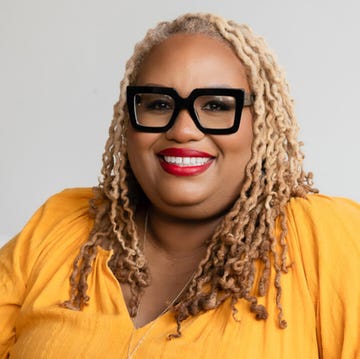I’d expected everything to be worse in China,” says Lily, one of the protagonists of Rachel Khong’s second novel, Real Americans. “I readily believed what I’d been told, that my American life was better than the lives my parents had left behind.” Seven months pregnant and on her first trip to Beijing, Lily has just met Ping, a professor her mother once knew, perhaps intimately. “What did I imagine?” she continues. “That he wouldn’t like music, that he wouldn’t enjoy tea? Which of us was living the richer life?”
Before she leaves his office, Ping tells Lily that she’s “a real American.” It doesn’t seem like a compliment.
Whereas Khong’s first novel, Goodbye, Vitamin, was slim and focused on a single point of view, Real Americans is sprawling, employing three narrators and spanning decades. More than anything, it’s a family saga, but the title speaks to the many questions that bubble under the surface here: What or who is a real American? Who gets to be or to be seen as one? Is it really so desirable? Is the United States so exceptional?
Khong opens with a brief prologue set in Beijing during the early days of Mao’s Cultural Revolution. After that, she introduces Lily. It’s the eve of the new millennium, and she is living in New York, where she is an unpaid intern at a travel magazine. Lily lacks the professional ambition her scientist mother has long tried to instill in her, and when she meets a beautiful white man, Matthew, at a work party, she gets swept up in a whirlwind romance, which includes a trip to Paris on their first date.
Matthew is that kind of wealthy; he works in finance and lives alone in an apartment so large that it seems insulting to New Yorkers such as Lily who dwell in tiny spaces. The yawning chasm of class differences—as well as the acceptance Matthew faces as opposed to the micro- and macroaggressions to which Lily is often subjected—makes their relationship seem, at first, unsustainable to Lily. But ultimately, she begins to lean into the ease she feels with him. When she learns he’s an heir to a pharmaceutical fortune, she’s peeved he hasn’t told her sooner—but his family soon charms her enough that she’s able to forgive.
Lily keeps worrying, though, about what her mother, Mei Ling—or May, as she spells her name in the United States—thinks about her newfound happiness. When she and Matthew decide they want a child, Lily wonders whether this will give her the meaning she never found in a career, and immediately knows how disappointing such a sentiment would be to her mother.
“An American woman like me, in the new millennium?” she reflects. “Couldn’t I use my imagination, my capabilities, to pursue a less conventional life? I knew I was lucky to have a mother who had never expected of me the old-fashioned things: marriage, a family. And yet this was what I wanted, as puzzling as it was to her.”
Eventually, Real Americans switches gears; the second part is narrated by Lily and Matthew’s child, whose name is Nick. He doesn’t know his father, only Lily, who has raised him by herself, on an island off the coast of Washington, where she’s kept him as technologically isolated as possible. (He doesn’t have a smartphone or his own computer.) Through a quirk of genetics, Nick is blond, blue-eyed, pale-skinned: the spitting image of the father he’s never met. As a result, he and Lily have never been legible to others as a family. Even after a DNA test proves he’s 50 percent Chinese, white people still feel comfortable dropping casually racist remarks around him, and when, in college, he begins to date a Black and Asian woman, he can tell she is sometimes suspicious of how ignorant he can be about his ability to pass.
Finally, of course, Nick does track Matthew down, and for a time he thinks he’s found a place where he belongs. In addition, he begins to experiment with the power he now understands he has. Yet as the mystery of his upbringing—why Lily took him and left Matthew—begins to unravel, things become more complicated.
The final part of Real Americans is in the voice of May and takes place some years later. Here, we witness the older woman’s memories of her upbringing in China: her ambitions, hopes, and dreams, as well as how her university education was violently interrupted by the Cultural Revolution. These events will later influence the sometimes impossible decisions she will have to make, and which will affect her daughter and grandson.
What does all this have to do with being American? Throughout the novel, Khong addresses a variety of American realities, from income inequality to racism to what gets lost in assimilation. At the same time, the unfolding plot reminds us that the United States, unique as its particular sins may be, is not the only nation with a troubled history. Khong is not saying something so trite as the grass is always greener, but instead that the perspectives and circumstances that shape our choices are legible sometimes only when understood in context.
As a student, May grows interested in biology because of “the astonishing intricacy of who we were born as and became. Invisible codes made us. Our cells carried the instructions with which we formed ourselves.” Who we are born as and become, in other words, are products of socialization as well as biology—and it is these invisible codes and instructions that Real Americans seeks to explore.•
Ilana Masad is a writer of fiction, nonfiction, and criticism. Masad is the author of the novel All My Mother’s Lovers and is co-editing a forthcoming anthology about The Bachelor franchise. Her new novel, Beings, comes out in September 2025.













